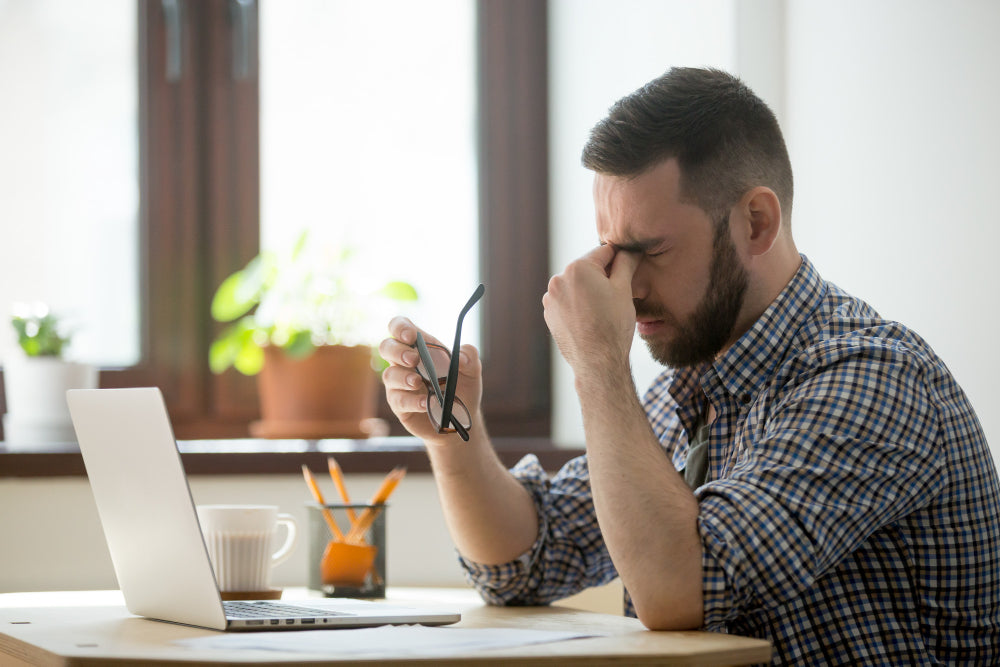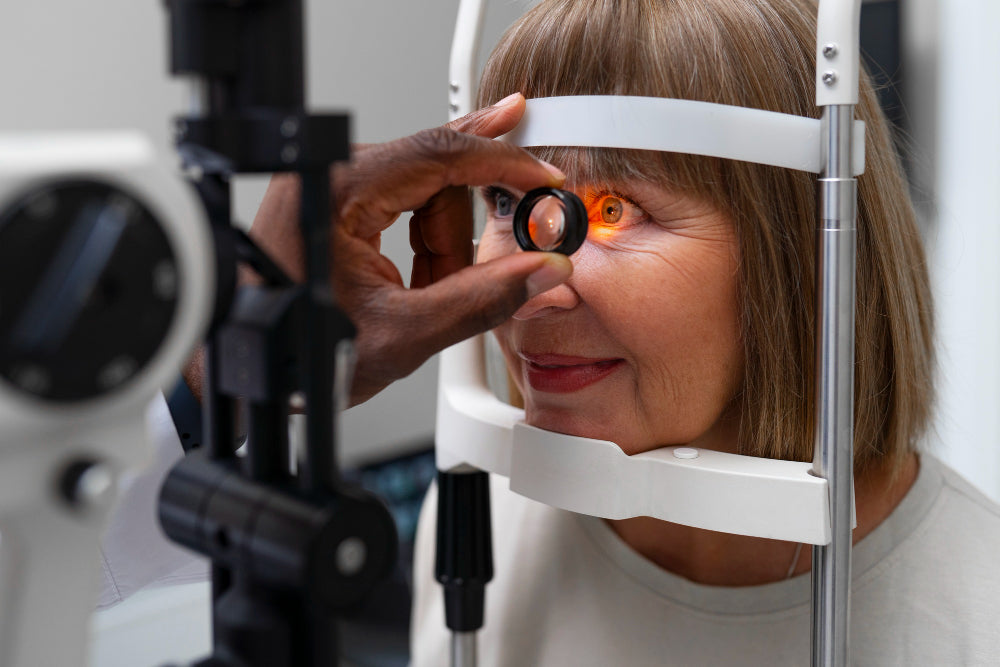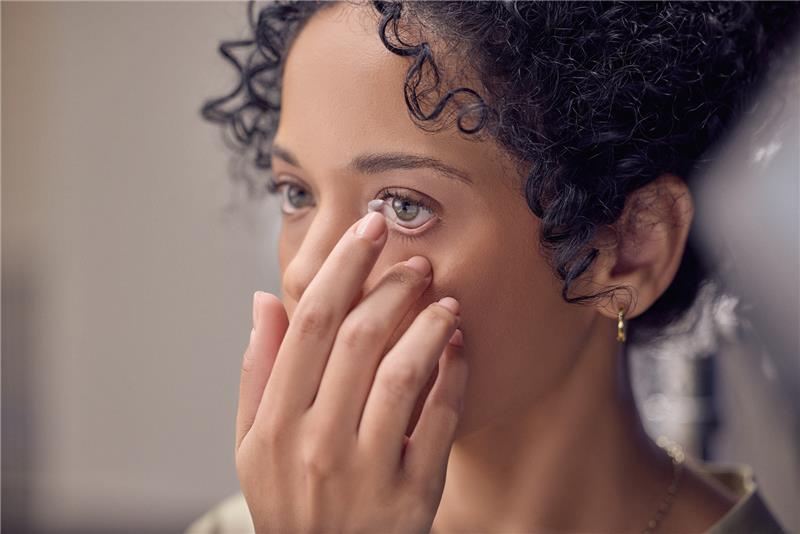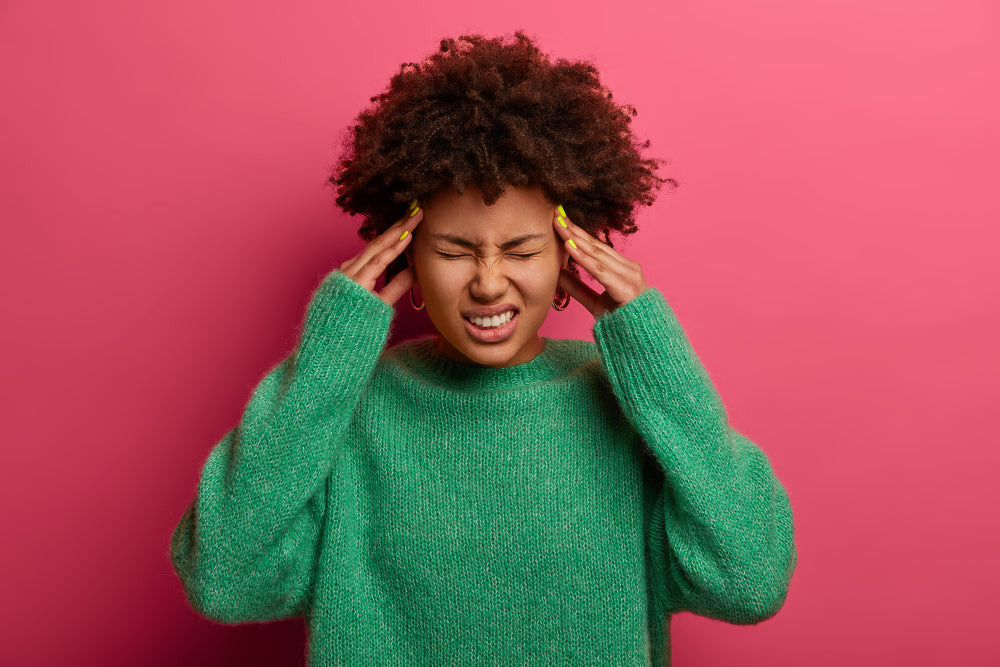Experiencing pain and pressure behind the eyes can be both uncomfortable and concerning. This sensation is often accompanied by symptoms such as headaches, pain, and even visual disturbances.
Are you struggling with a nagging feeling of pressure in your eyes and headache? Discover how to relieve it. Try applying a cool compress and practicing relaxation techniques like deep breathing to relieve pressure behind the eyes. If symptoms persist, consult a healthcare professional.
Many people wonder why there is pressure behind their eyes and what can be done to alleviate this discomfort.This blog post will explore the pressure behind the eyes, its common causes, and effective ways to manage and prevent it.
What is Pressure Behind the Eye?

Pressure behind the eyes refers to a sensation of fullness or pressure behind the eye socket. This feeling can be caused by various factors, ranging from minor issues like sinus infections to more severe conditions such as optic neuritis.
Pressure behind the eyes is a sensation that can be described as a feeling of fullness, tightness, or discomfort situated at the back of the eyeball. This sensation can be alarming and may produce various symptoms, which can help identify its underlying causes.
Common Symptoms of Pressure Behind the Eye
Common pressure symptoms behind the eyes include headaches, eye pain, and sometimes even vision problems. Identifying these symptoms early is essential to effectively treating the underlying causes.
- Headache: A headache is one of the most frequent symptoms associated with pressure behind the eye. It can range from a mild, dull ache to a severe, throbbing pain.
- Eye Pain: Individuals often experience direct pain in and around the eye itself. This pain can be constant or intermittent. It can be worse with eye movement.
- Blurry Vision: Another symptom is blurred vision, which can affect one or both eyes. This may come and go or persist over time.
- Redness and Swelling: The eye may appear red, and there might be noticeable swelling around the eye or eyelid.
- Sensitivity to Light: Also known as photophobia, sensitivity to light can make it uncomfortable to be in any illuminated environment.
- Watery Eyes: Excessive tearing, aka watery eyes, can come with the sensation of pressure behind the eye.
- Nasal Congestion: Pressure behind the eye is sometimes linked to sinus issues, resulting in nasal congestion or a stuffy nose.
- Double Vision: In some cases, individuals may experience double vision, which can be particularly disorienting.
Additional Considerations
Understanding the symptoms associated with pressure behind the eye is crucial, as it can indicate various underlying conditions. These symptoms do not occur in isolation and may be part of a broader medical issue that requires professional evaluation.
Uncovering the Causes of Eye Pressure Pain

Several conditions can lead to the sensation of pressure behind the eyes. Understanding these causes can help in seeking appropriate treatment and relief. Here are some common causes of eye pressure pain:
- Sinus Infections: One common cause of eye pressure pain is sinus infections or sinusitis. The sinuses are air-filled cavities that are close to the eyes. When they become infected or inflamed, the resulting swelling can exert pressure on the surrounding areas, including the eyes. Symptoms often include a headache, nasal congestion, and facial pain.
- Migraines: Migraines are severe headaches that can cause significant pressure behind the eyes. These headaches are mostly accompanied by other symptoms. This includes nausea, vomiting, and sensitivity to light and sound. The pain from a migraine typically affects one side of the head but can radiate to the eyes, creating a sensation of pressure.
- Graves' Disease: This autoimmune disorder affects the thyroid gland and can lead to thyroid eye disease. As the body's immune system attacks the tissues around the eyes, it can cause swelling, inflammation, and bulging of the eyes, resulting in pressure and discomfort.
- Optic Neuritis: Optic neuritis is an optic nerve inflammation: the optic nerve transmits visual information from the eyes to the brain. This condition can cause eye pain, particularly with eye movement, vision loss, and a sensation of pressure behind the eyes. It is often related to multiple sclerosis but can occur independently.
- Toothaches: Dental issues, particularly those affecting the upper teeth, can also cause pressure behind the eyes. Infections or abscesses in the upper jaw can extend to the sinuses and the area around the eyes, leading to a referred pain that feels like pressure behind the eyes.
Each condition involves different mechanisms and treatments, making it essential to accurately diagnose the cause of eye pressure pain and address it effectively.
How to Relieve Pressure Behind Eyes

Experiencing pressure behind the eyes can be uncomfortable and distracting. Relieving pressure behind the eyes can involve both medical treatments and home remedies. Here are some practical ways to alleviate this discomfort:
Targeted Relief with Eye Drops
Lubricating Eye Drops: These can relieve the pressure due to dryness.
Prescription Eye Drops: For glaucoma, prescription drops can reduce intraocular pressure.
Over-the-Counter Medications: Pain relievers and decongestants help reduce sinus pressure and headaches.
Cool Compresses: Applying a gentle, cool compress to the affected area helps relieve sinus pressure.
Hydration: Drinking fluids can help thin mucus and reduce sinus pressure.
Rest: Ensuring adequate rest and sleep can help alleviate headaches and eye strain.
Medical Treatments: For conditions like Graves' disease or optic neuritis, specific medical treatments prescribed by an eye doctor are necessary.
Surgery: In severe cases, such as chronic sinusitis, surgical intervention may be necessary to alleviate sinus pressure behind the eyes.
Professional Evaluation: Always talk with a healthcare professional to determine the precise cause of the pressure and receive personalized treatment.
Effective Home Remedies

Cool Compress
Apply a cool, damp cloth over your eyes for a few minutes. This simple remedy can help relieve sinus pressure caused by allergies.
Hydration
Stay hydrated by the intake of adequate water daily. Proper hydration helps thin mucus, alleviating sinus pressure if sinus issues contribute to discomfort. Rule of thumb: when thirsty, drink water.
Steam Inhalation
Inhale steam from a big bowl of hot water or shower to help open up nasal passages. This method can effectively reduce pressure and promote sinus health.
Rest
Get adequate rest. Overworking your eyes, especially during periods of high stress or extended screen time, can worsen the feeling of pressure behind your eyes.
Essential Oils
Use essential oils like eucalyptus or peppermint to help reduce sinus discomfort. These can be inhaled directly from a diffuser or applied topically around the sinuses, diluted with a carrier oil.
Adjusting Screen Time
Limit your screen time and ensure you take frequent breaks during long sessions. This can help reduce eye strain and dry eyes, which can cause a feeling of pressure behind your eyes.
Understanding how to relieve pressure behind the eyes involves a combination of these methods. Each individual may find relief through different approaches, so exploring medical treatments and home remedies is essential to see what works best for you.
Headache Causing Pressure Behind Eyes

Headaches are a common cause of pressure behind the eyes. Different headaches, such as tension and cluster headaches, can lead to this uncomfortable sensation. Tension headaches often hurt and feel like a tight band around the head, while cluster headaches are characterized by severe pain around one eye. Understanding the type of headache you are experiencing helps you find the proper treatment and relief.
The sensation of pressure behind the eyes is a common symptom of headaches. Understanding the connection between headaches and this specific type of discomfort can be crucial for effective diagnosis and treatment.
Tension Headaches
Tension headaches are the most common type, often resulting in a dull, aching pain that can spread across the forehead, temples, and even the back of the head. These headaches can also lead to a feeling of pressure behind the eyes.
The muscles around the eyes, neck, and scalp can become tight and strained, contributing to this sensation. Stress, poor posture, and eye strain become common triggers for tension headaches. Time to get that prescription checked!
Migraine Headaches
Migraines are another type of headache that can cause severe pain and pressure behind the eyes. Migraines are often accompanied by other annoying symptoms like nausea, sensitivity to light and sound, and even vomiting. Visual aura, consisting of flashing lights, spotty vision, or scintillating lines occurs with roughly half of all migraine headaches.
You can have a visual aura without a headache or a headache ache without visual aura. Either way, you can experience pressure behind your eyes. A migraine's throbbing pain can intensify the pressure in the ocular region, making it feel like a headache behind the eyes. Triggers for migraines can include certain foods, hormonal changes, and environmental factors.
Cluster Headaches
Cluster headaches, often described as the most severe type of headache, are characterized by intense, piercing pain around one eye. The pain can expand to the forehead, temple, and cheek, creating concentrated pressure behind the eyes. These headaches occur in cycles or clusters, often at the same time of day and lasting weeks or even months. Cluster headaches typically occur in men and can wake the patient up in the middle of the night. They are frequently described as a sharp, stabbing pain. The exact reason for cluster headaches is not well understood, but they are believed to be related to abnormalities in the hypothalamus.
Sinus Headaches
Sinus headaches result from inflammation and congestion of the sinuses, leading to a pressing sensation around the eyes, forehead, and cheeks. The buildup of mucus and pressure in the sinus cavities can make it feel like a headache behind the eyes, often accompanied by nasal congestion, fever, and facial swelling. Treating the underlying sinus infection or inflammation typically alleviates headaches and eye pressure.
Eyestrain and Headaches
Extended periods of focusing on screens or reading can cause eyestrain, leading to discomfort and pressure behind the eyes. Moreover, eye strain can exacerbate other types of headaches, making the overall experience more painful and debilitating. Regular breaks, adjusting lighting, and using proper eyewear can help mitigate eyestrain and the associated pressure behind the eyes.
By recognizing the different types of headaches and their connection to pressure behind the eyes, individuals can better understand their symptoms and seek the appropriate treatment. Whether it's a tension headache, migraine, cluster headache, or sinus-related issue, addressing the specific cause will help relieve the discomfort and improve quality of life.
How to Maintain Healthy Eye Pressure

Maintaining healthy eye pressure is essential for preventing discomfort and potential eye problems. Here are some tips to help you keep your eye pressure in check:
Regular Eye Check-Ups
- Annual Eye Examinations: Schedule regular eye exams with your Eye Doctor. These professionals can measure your eye pressure and detect early symptoms of glaucoma and other eye conditions.
- Intraocular Pressure (IOP) Measurements: During eye check-ups, ensure that your intraocular pressure is measured. High IOP can be a risk factor for glaucoma and needs to be monitored regularly.
Managing Underlying Health Conditions
- Control Blood Pressure: High blood pressure can increase eye pressure. If necessary, maintain healthy blood pressure through diet, exercise, and medication.
- Diabetes Management: Diabetes can also affect your eye health. Keep your blood sugar levels under control to lessen the risk of diabetic retinopathy and other eye issues.
- Medications: Be aware of medications that can increase eye pressure. Consult your physician about the side effects of any medication you take and whether they might affect your eye pressure.
Lifestyle Changes
- Regular Exercise: Engage in moderate physical activities, such as walking, swimming, or yoga. Exercise can help lower eye pressure, reduce stress, and improve overall health.
- Healthy Diet: Keto, ketovore, and carnivore are your best options. Healthy fats are your friends. Avoid processed foods, seed oils, trans fats, and sugar. Get familiar with Dr. Ken Berry’s Proper Human Diet.
- Hydration: Drink water when thirsty. Your kidneys know best. Staying hydrated can help maintain the fluid balance in your eyes, ensuring optimal moisture and comfort. Regular hydration has numerous benefits, including improved eye health and function.
- Limit Caffeine and Alcohol: Excessive caffeine and alcohol consumption can raise eye pressure. Moderation is vital in maintaining healthy eye pressure.
Conclusion
In conclusion, understanding the causes and symptoms of pressure behind the eyes is crucial for seeking appropriate relief. Various factors can contribute to this discomfort, from headaches to sinus infections and eye conditions.
By implementing practical home remedies, seeking medical advice when needed, and adopting healthy lifestyle habits, you can effectively manage pressure behind the eyes and improve your overall eye health. Remember, persistent symptoms should always be evaluated by an eye care professional to ensure accurate diagnosis and appropriate treatment. Early detection and intervention are key to preventing potential complications and ensuring long-lasting comfort.
You Might Also Like:





